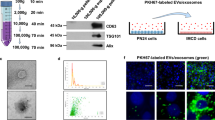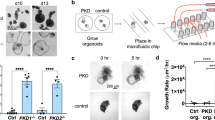Summary
Cells from the cysts of patients with autosomal dominant polycystic kidney disease (PKD) were grown in vitro under standard conditions without the aid of collagen-pretreated surfaces, and both the synthesis and composition of the extracellular matrix were investigated. At confluence, PKD cells presented the typical features of epithelial cells, but showed a different collagen composition from fibroblasts. Compared with normal tubular epithelia (NTE), PKD monolayers produced an excess of extracellular matrix, which accounted for 30% of the total incorporation of [3H] proline, although this value was considerably lower (by a factor of 10) in the case of NTE. Immunohistochemical and electrophoretic techniques revealed a complex collagen composition in the extracellular matrix which included [α(III)]3 and collagen IV. However, part of the collagen components remained unidentified in spite of the fact that they exhibited a typical Mr of α1(I) and α2(I) in the presence of urea. Immunoprecipitation with monospecific antibodies and Northern blotting with specific probes failed to recognize α1(I) and α2(I), but demonstrated their presence in fibroblasts. Purification and cyanogen bromide digestion demonstrated a strong interhomology in fingerprint peptide composition among the uncharacterized collagens synthesized by PKD cells, thus suggesting a common identity. These observations document a markedly augmented production of extracellular matrix by PKD cultured cells in vitro, and show the presence of collagens which do not share homologies with the major collagen molecules. A better characterization of extracellular matrix composition is central to any comprehension of the cystogenetic mechanisms in vivo.
Similar content being viewed by others

References
Avner ED, Sweeney WE, Finegold DN, Piesco NP, Ellis D (1984) Sodium-potassium ATPase activity mediates cyst formation in metanephritic organ culture. Kidney Int 28:447–455
Butkowski RJ, Carone FA, Grantham JJ, Hudson BG (1985) Tubular basement membrane changes in 2-amino-4,5-diphenyl-thiazole-induced polycystic disease. Kidney Int 28:744–751
Carone FA, Randal FG, Perlman SG, Ganote F (1974) The pathogenesis of drug-induced renal cystic disease. Kidney Int 5:411–421
Carone FA, Makino H, Kanwar YS (1988) Basement membrane antigens in renal polycystic disease. Am J Pathol 130:466–471
Carone FA, Nakamura S, Schumacher BS, Punyarit P, Bauer KD (1989) Cyst-derived cells do not exhibit accelerated growth or features of transformed cells in vitro. Kidney Int 35:1351–1357
Chung SD, Alavi N, Livingston D, Hiller S, Taub M (1982) Characterization of primary rabbit kidney that express proximal tubule functions in a hormonally defined medium. J Cell Biol 95:118–126
Colombatti P, Bonaldo P, Aidinger K, Bressman GM, Volpin D (1987) Biosynthesis of chik type IV collagen. J Biol Chem 262:14454–14460
Creely JJ, Commers PA, Haralson M (1988) Synthesis of type III collagen by cultured kidney epithelial cells. Connect Tissue Res 18:107–122
Detrisac CJ, Sens MA, Garvin AJ, Spicer SS, Sens DA (1984) Tissue culture of human kidney epithelial cells of proximal tubule origin. Kidney Int 25:118–126
Dobylan DC, Hill D, Lewis T, Bulger RE (1981) Cyst formation in rat kidney induced by cis-platinum administration. Lab Invest 45:260–268
Ebihara I, Killen PD, Laurie GW, Huang T, Yamada Y, Martin GR, Brown KS (1988) Altered mRNA expression of basement membrane compounds in a murine model of polycystic kidney disease. Lab Invest 58:262–269
Evan AP, Gardner KD, Bernstein J (1979) Polypoid and papillary epithelial hyperplasia: a potential cause of ductal obstruction in adult polycystic disease. Kidney Int 16:743–750
Gardner KD, Soloman S, Fitzgerrel WW, Evan AP (1976) Function and structure in the diphenylamine-exposed kidney. J Clin Invest 57:796–806
Glanville RW, Router A, Feitrek AP (1979) Isolation and characterization of a native placental basement-membrane collagen and its component chairs. J Biochem 95:383–389
Gorg A, Pastel W, Gunther S (1988) The current state of two dimensional electrophoresis with immobilized pH gradients. Electrophoresis 9:531–546
Granot Y, Van Putten V, Przekwas S, Garban A, Schrier R (1990) Intra and extracellular proteins in human normal and polycystic kidney epithelial cells. Kidney Int 37:1301–1309
Grantham JJ (1983) Polycystic kidney disease: physiology of giant nephrons. Am J Physiol 244:F3–10
Hall HG, Farson DA, Bissei MJ (1982) Reversible formation by epithelial cell lines in response to collagen overlay: a morphogenic model in culture. Proc Natl Acad Sci USA 79:4672–4676
Kanwar TS, Carone FA (1984) Reversible changes of tubular cells and basement membrane in drug-induced cystic disease. Kidney Int 26:35–43
Kleinman HK, Klebe RJ, Martin GR (1981) Role of collagenous matrices in the adhesion and growth of cells. J Cell Biol 88:473–485
Laemmli UK (1970) Cleavage of structural proteins during the assembly of the head of bacteriophage T4. Nature 227:680–685
Linsenmayer TF (1981) Collagen. In: Hay ED (ed) Cell biology of extracellular matrix. Plenum Press, New York, pp 5–37
Mangoo-Karim R, Uchic M, Lechene C, Grantham JJ (1989) Renal epithelia cyst formation and enlargement in vitro: dependence on cAMP. Proc Natl Acad Sci USA 86:6007–6011
Maniatis T, Fritsch F, Sambrook J (1982) Molecular cloning: a laboratory manual. Cold Spring Harbor, New York, pp 202–203
McAteer JA, Evan AP, Gardner KD (1987) Morphogenic clonal growth of kidney epithelial cell line MDCK. Anat Rec 217:229–239
Merril CR, Goldman D, Van Kauren ML (1982) Simplified silver protein dection and image enhancement methods in polyacrylamide gels. Electrophoresis 3:17–23
Mon-Li Chu, Wit W de, Bernard M, Juy-Fang Ding, Marabito M, Myers JC, Williams C, Ramirez R (1984) Human pro α1 (I) collagen gene structure reveals evolutionary conservation of a pattern of introns and exons. Nature 310:337–340
Mutti A, Lucertini S, Valcalvi PP, Neri TM, Fornari M, Alinovi R, Franchini I (1985) Urinary excretion of brush-border antigen: early indicator of toxic nephropathy. Lancet II:914–917
Myers JC, Mon-Li Chu, Faro SM, Clark SM, Prockop CJ, Ramirez F (1981) Cloning a cDNA for the pre-α2 chain of human type I collagen. Proc Natl Acad Sci USA 78:3516–3520
Seligman AM, Rutenberg AM (1951) The histochemistry demonstration of succinic dehydrogenase. Science 113:317–320
Singer KH, Scearce RM, Tuck DT, Whichard LP, Denning SM, Haynes BF (1989) Removal of fibroblasts from human epithelial cell cultures with use of a complement fixing monoclonal antibody reactive with human fibroblasts and monocytes/mac-rophages. J Invest Dermatol 92:166–170
Sokolov BP, Sher BM, Kalinin VN (1989) Modified method for peptic mapping of collagen chains using cyanogen bromidecleavage of proteins within polyacrylamide gels. Anal Biochem 176:365–367
Taub M, Laurie GW, Martin GR, Kleiman HK (1990) Altered basement membrane protein synthesis by primary cultures of CPK/CPK mouse kidney. Kidney Int 37:1090–1097
Toman PD, Ricca GA, Crombrugghe B de (1988) Nucleotide sequence of a cDNA coding for the amino-terminal region of human prepro α1 (III) collagen. Nucleic Acids Res 16:7201
Wilson PD, Schrier RW, Breckson RD, Gabow PA (1908) New method for studying huma polycystic kidney disease epithelia in culture. Kidney Int 30:371–378
Author information
Authors and Affiliations
Rights and permissions
About this article
Cite this article
Candiano, G., Gusmano, R., Altieri, P. et al. Extracellular matrix formation by epithelial cells from human polycystic kidney cysts in culture. Virchows Archiv B Cell Pathol 63, 1–9 (1993). https://doi.org/10.1007/BF02899238
Received:
Accepted:
Issue Date:
DOI: https://doi.org/10.1007/BF02899238



